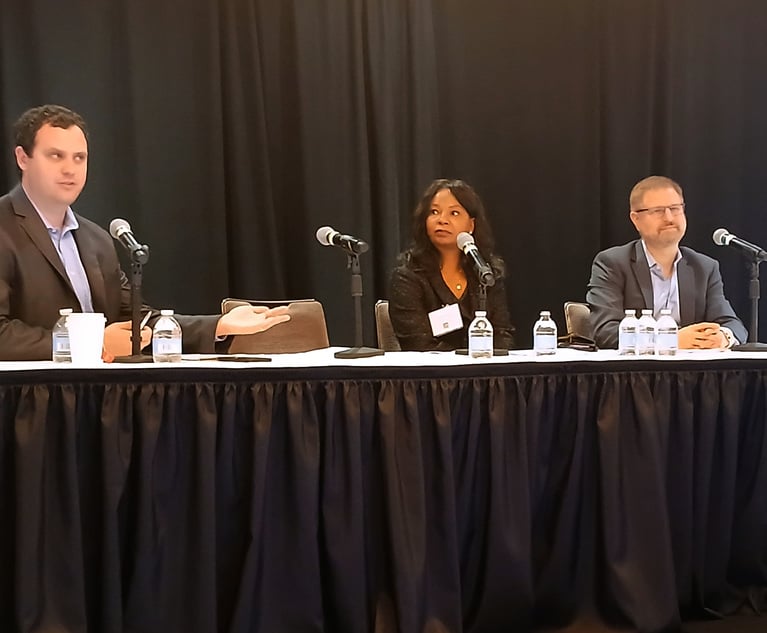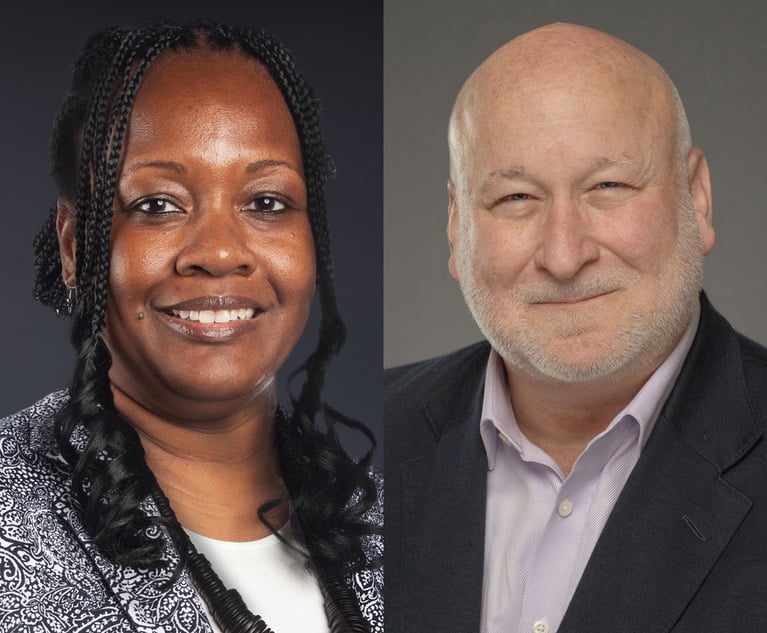Midsize law firms take a bigger piece of big-ticket litigation
Over the past three years, midsize law firms with 201 to 500 lawyers have nearly doubled their share of big-ticket litigation.
October 22, 2013 at 07:02 AM
5 minute read
The original version of this story was published on Law.com
As more organizations look to cut costs when it comes to litigation, smaller firms are starting to get a bigger piece of lucrative corporate work as general counsel become savvier shoppers, according to a new study.
In fact, over the past three years, midsize law firms with 201 to 500 lawyers have nearly doubled their share of big-ticket litigation. The figure has risen to 41 percent from 22 percent of the work that generates more than $1 million in legal bills, based on the results of a new LexisNexis CounselLink report, “Enterprise Legal Management Trends.”
One of the key trends driving this shift is the percentage of legal work a client provides to its top 10 law firms – 57 percent of companies surveyed have 10 or fewer firms accounting for at least 80 percent of outside legal fees. Another factor driving this trend is the frequency in which so-called large-enough firms offer alternative fee arrangements (AFAs) to their clients relative to the frequency with which the largest 50 offer AFAs.
Across the U.S., the average partner-billing rate was $381 per hour for the 12 months ending June 30, 2013 – up 2.7 percent from the previous year. The practice area with the highest hourly partner rate is mergers and acquisitions, which bills at an average of $630 per hour.
The equation is usually “the larger the firm the higher the cost,” Don H. Liu, general counsel for Xerox Corp., told The Wall Street Journal. Liu reportedly uses marquee law firms for critical transactions, but keeps the company's legal bills down by sending other work to smaller law firms in low-cost locations.
“Big law firms don't have a monopoly on talent,” he said.
Among the 15 largest U.S. cities, Philadelphia, Detroit, San Francisco, Atlanta and New York are the five cities where law firm hourly billing rates increased above 2.5 percent in both year-over-year and three-year compound annual growth rate (CAGR). Lagging behind are Phoenix, Boston, Houston, Dallas and Minneapolis.
In recent years, legal departments and law firms have slowly become more creative in finding non-hourly arrangements for more complex work to help their clients manage and predict legal expenses while still providing a comfortable level of profitability for law firms, according to Kris Satkunas, director of Strategic Consulting at LexisNexis CounselLink. Click here to read more on analyzing big data for the details on AFAs.
As more organizations look to cut costs when it comes to litigation, smaller firms are starting to get a bigger piece of lucrative corporate work as general counsel become savvier shoppers, according to a new study.
In fact, over the past three years, midsize law firms with 201 to 500 lawyers have nearly doubled their share of big-ticket litigation. The figure has risen to 41 percent from 22 percent of the work that generates more than $1 million in legal bills, based on the results of a new
One of the key trends driving this shift is the percentage of legal work a client provides to its top 10 law firms – 57 percent of companies surveyed have 10 or fewer firms accounting for at least 80 percent of outside legal fees. Another factor driving this trend is the frequency in which so-called large-enough firms offer alternative fee arrangements (AFAs) to their clients relative to the frequency with which the largest 50 offer AFAs.
Across the U.S., the average partner-billing rate was $381 per hour for the 12 months ending June 30, 2013 – up 2.7 percent from the previous year. The practice area with the highest hourly partner rate is mergers and acquisitions, which bills at an average of $630 per hour.
The equation is usually “the larger the firm the higher the cost,” Don H. Liu, general counsel for Xerox Corp., told The Wall Street Journal. Liu reportedly uses marquee law firms for critical transactions, but keeps the company's legal bills down by sending other work to smaller law firms in low-cost locations.
“Big law firms don't have a monopoly on talent,” he said.
Among the 15 largest U.S. cities, Philadelphia, Detroit, San Francisco, Atlanta and
In recent years, legal departments and law firms have slowly become more creative in finding non-hourly arrangements for more complex work to help their clients manage and predict legal expenses while still providing a comfortable level of profitability for law firms, according to Kris Satkunas, director of Strategic Consulting at
This content has been archived. It is available through our partners, LexisNexis® and Bloomberg Law.
To view this content, please continue to their sites.
Not a Lexis Subscriber?
Subscribe Now
Not a Bloomberg Law Subscriber?
Subscribe Now
NOT FOR REPRINT
© 2025 ALM Global, LLC, All Rights Reserved. Request academic re-use from www.copyright.com. All other uses, submit a request to [email protected]. For more information visit Asset & Logo Licensing.
You Might Like
View All
Lawyers Drowning in Cases Are Embracing AI Fastest—and Say It's Yielding Better Outcomes for Clients

GC Conference Takeaways: Picking AI Vendors 'a Bit of a Crap Shoot,' Beware of Internal Investigation 'Scope Creep'
8 minute read
Why ACLU's New Legal Director Says It's a 'Good Time to Take the Reins'
Trending Stories
- 1'True Leadership Is About Putting Others First': 2024 In-House Award Winners Inspired, Took Road Less Traveled
- 2A Q&A with Sidley Austin's London Leader
- 3New York-Based Harris Beach Combines With Connecticut-Based Murtha Cullina, Forming NE Powerhouse
- 4New Year, New Am Law 100: Challenges Await These Newly Merged Law Firms
- 5Thursday Newspaper
Who Got The Work
Michael G. Bongiorno, Andrew Scott Dulberg and Elizabeth E. Driscoll from Wilmer Cutler Pickering Hale and Dorr have stepped in to represent Symbotic Inc., an A.I.-enabled technology platform that focuses on increasing supply chain efficiency, and other defendants in a pending shareholder derivative lawsuit. The case, filed Oct. 2 in Massachusetts District Court by the Brown Law Firm on behalf of Stephen Austen, accuses certain officers and directors of misleading investors in regard to Symbotic's potential for margin growth by failing to disclose that the company was not equipped to timely deploy its systems or manage expenses through project delays. The case, assigned to U.S. District Judge Nathaniel M. Gorton, is 1:24-cv-12522, Austen v. Cohen et al.
Who Got The Work
Edmund Polubinski and Marie Killmond of Davis Polk & Wardwell have entered appearances for data platform software development company MongoDB and other defendants in a pending shareholder derivative lawsuit. The action, filed Oct. 7 in New York Southern District Court by the Brown Law Firm, accuses the company's directors and/or officers of falsely expressing confidence in the company’s restructuring of its sales incentive plan and downplaying the severity of decreases in its upfront commitments. The case is 1:24-cv-07594, Roy v. Ittycheria et al.
Who Got The Work
Amy O. Bruchs and Kurt F. Ellison of Michael Best & Friedrich have entered appearances for Epic Systems Corp. in a pending employment discrimination lawsuit. The suit was filed Sept. 7 in Wisconsin Western District Court by Levine Eisberner LLC and Siri & Glimstad on behalf of a project manager who claims that he was wrongfully terminated after applying for a religious exemption to the defendant's COVID-19 vaccine mandate. The case, assigned to U.S. Magistrate Judge Anita Marie Boor, is 3:24-cv-00630, Secker, Nathan v. Epic Systems Corporation.
Who Got The Work
David X. Sullivan, Thomas J. Finn and Gregory A. Hall from McCarter & English have entered appearances for Sunrun Installation Services in a pending civil rights lawsuit. The complaint was filed Sept. 4 in Connecticut District Court by attorney Robert M. Berke on behalf of former employee George Edward Steins, who was arrested and charged with employing an unregistered home improvement salesperson. The complaint alleges that had Sunrun informed the Connecticut Department of Consumer Protection that the plaintiff's employment had ended in 2017 and that he no longer held Sunrun's home improvement contractor license, he would not have been hit with charges, which were dismissed in May 2024. The case, assigned to U.S. District Judge Jeffrey A. Meyer, is 3:24-cv-01423, Steins v. Sunrun, Inc. et al.
Who Got The Work
Greenberg Traurig shareholder Joshua L. Raskin has entered an appearance for boohoo.com UK Ltd. in a pending patent infringement lawsuit. The suit, filed Sept. 3 in Texas Eastern District Court by Rozier Hardt McDonough on behalf of Alto Dynamics, asserts five patents related to an online shopping platform. The case, assigned to U.S. District Judge Rodney Gilstrap, is 2:24-cv-00719, Alto Dynamics, LLC v. boohoo.com UK Limited.
Featured Firms
Law Offices of Gary Martin Hays & Associates, P.C.
(470) 294-1674
Law Offices of Mark E. Salomone
(857) 444-6468
Smith & Hassler
(713) 739-1250







